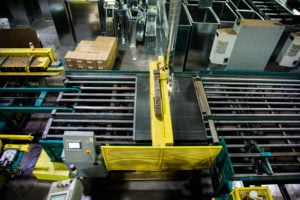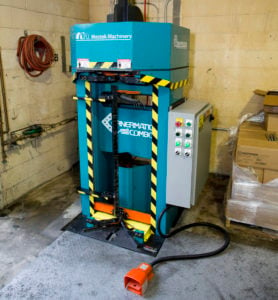Whether you’re a sheet metal worker planning to eventually open your own shop or a very small company owner ready to expand beyond the world of hammers and snips, knowing what equipment to invest in is essential.
Not every piece of sheet metal machinery is a must-have for every shop, and knowing the difference between a nice-to-have and a required item for your business can help turn a struggling shop into a profitable one.
We asked Dave Pedersen, a machinery sales engineer with Mestek Machinery, to discuss a few of the pieces of equipment that a modern, competitive sheet metal shop needs to succeed. This list is not all-inclusive, but it does include a few pieces that many experts would say are necessary. Some of the items that Pedersen says a modern ductwork fabrication shop should have are pretty obvious, but a few might surprise you.
1. A plasma cutting table
“To fabricate fittings, really the first piece of machinery that you’re going to need is a plasma cutting table,” Pedersen says. “Otherwise you’re just cutting metal by hand all day, and you’re not going to be able to keep up with the shops using a plasma table.”
This is not an inexpensive investment, but arguably no other piece of equipment in the last four decades has revolutionized the worlds of HVAC and duct fabrication like the computer-controlled plasma table. By using a computer to guide the plasma arc, cuts are clean and quick, saving hours compared with the manual process.
2. A press brake
You’d be hard-pressed to come across any sheet metal fabrication shops that don’t have a press brake, such as a Roto-Die. This widely popular machine allows shops to perform a variety of predetermined bends to lengths of sheet metal. With a wide variety of dies available for press brakes, shops are able to perform tasks such as bead, do 90-degree bends, offset angles, and even produce flange profiles such as TDC and TDF (the SMACNA standards) on straight sections and fittings, to name a few.
“The versatility and overall capabilities that a press brake offers makes them a no-brainer for sheet metal shops to have. It’s pretty easy to see why most shops have one out on their floor,” Pedersen says.
3. A Pittsburgh machine
This popular machine, which dates back almost 80 years, allows sheet metal workers to create a perfectly formed seam running the length of the duct. It works by feeding metal sheets through a series of rollers. The seam is made as it passes through the rollers. It replaced the hand brake as the most common way to create a seam.
And while the machinery has been a mainstay of sheet metal shops for decades, Pedersen says there are still some businesses in the “Stone Age” that don’t have them. That’s a mistake, he adds, especially when you consider that making sheet metal fittings by brake is not a good use of time for most shops.
“It’s all about time,” Pedersen says. “The faster you can do it, the better it is for shops. This is especially true when it comes to fittings because there’s just not a lot of money in fittings. Speed and efficiency is the goal, and a Pittsburgh machine helps achieve this goal.”
4. A cleatformer with inboard and outboard forming positions
This machine offers shops the ability to produce “S” and “D” cleats on the two inboard forming positions, while offers shops a wide variety of auxiliary roll set profile options on the two outboard forming positions. These auxiliary roll set profiles can include large and small “male” and “female” Pittsburgh seams, “male” and “female” button punch snap-lock seams, or a combination 3-in-1 right angle flange/standing-seam/T-connection profiles.
“This machine allows the shop to quickly and easily produce a wide variety of useful profiles and cleats with a single machine. It also can cut the ‘slip’ and ’drive’ cleats to length, so you can make them as needed without any wasted metal. It equates to savings in time and money, not to mention invaluable floor space. It’s an incredibly useful machine that meets a lot of different shop needs,” Pedersen says.
5. A corner-insertion machine
This choice may surprise some sheet metal workers who have memories of early versions of this equipment or have never thought about automating the process.
“Corner insertion is often overlooked,” Pedersen says. “Shops continue to hammer corners in with their fittings and straight sections without giving it much of a thought. They don’t realize how much time and effort this is costing them and their employees. For example, at 7 am a sheet metal worker is able to hammer corners as quickly as he will all day. You look at that same sheet metal worker at 2 pm, and that hammer is a whole lot heavier to him after banging in corners all day. He’s not nearly as quick or efficient at getting these corners inserted. Corner insertion machines don’t get tired, and they produce perfect results every single time.”
While creating machines that did corner insertion was a good idea, in practice early editions of these machines had drawbacks that led many shops to stop using them. The drawbacks were most apparent and problematic in the single-head version of these machines. This led shops to continue hammering or crimping them in manually. However, since these early editions, manufacturers like Iowa Precision have addressed the various drawbacks previously experienced by shops. Today’s machines have been completely redesigned and are far more user-friendly and efficient. Aside from the single-head version, dual-head versions are also available and allow corners to be put into upper and lower duct sections as it comes off the coil line.
“If you’re doing a lot of straight sections or fittings, these are definitely machines that every shop should have,” Pedersen says. “It’s going to save a lot of valuable time for shops. I’ve been to shops where guys are literally on their hands and knees on the ground hammering these comers in. They hammer in corners on the bottom of sections, and then they have to flip these sections over and do it all over again. It’s just not an efficient method. Automating the process gets these corners put in at least two to three times as quickly without much effort. Now, instead of hammering corners in, that employee can help out in other areas of the shop.”



